Coronary Heart Disease: Prevalence and Determinants in Australia
VerifiedAdded on 2023/04/08
|6
|1083
|395
Report
AI Summary
This report provides an overview of coronary heart disease (CHD) in Australia. It begins with an introduction to cardiovascular disease (CVD) and its significance as a major cause of disease burden and death in the country. The report then focuses on CHD, also known as ischaemic heart disease, detailing its prevalence, mortality rates, and sex bias, with data spanning from 1968 to 2015. The core of the report explores the social determinants of CHD, including socioeconomic status (SES), physical environment, and genetics, and their impact on the disease's prevalence. It highlights how factors like income, education, housing, and exposure to environmental pollutants contribute to the risk of CHD, particularly among the Aboriginal population. The report emphasizes the need for healthcare providers to understand these social determinants to develop effective management strategies for CHD in Australia.
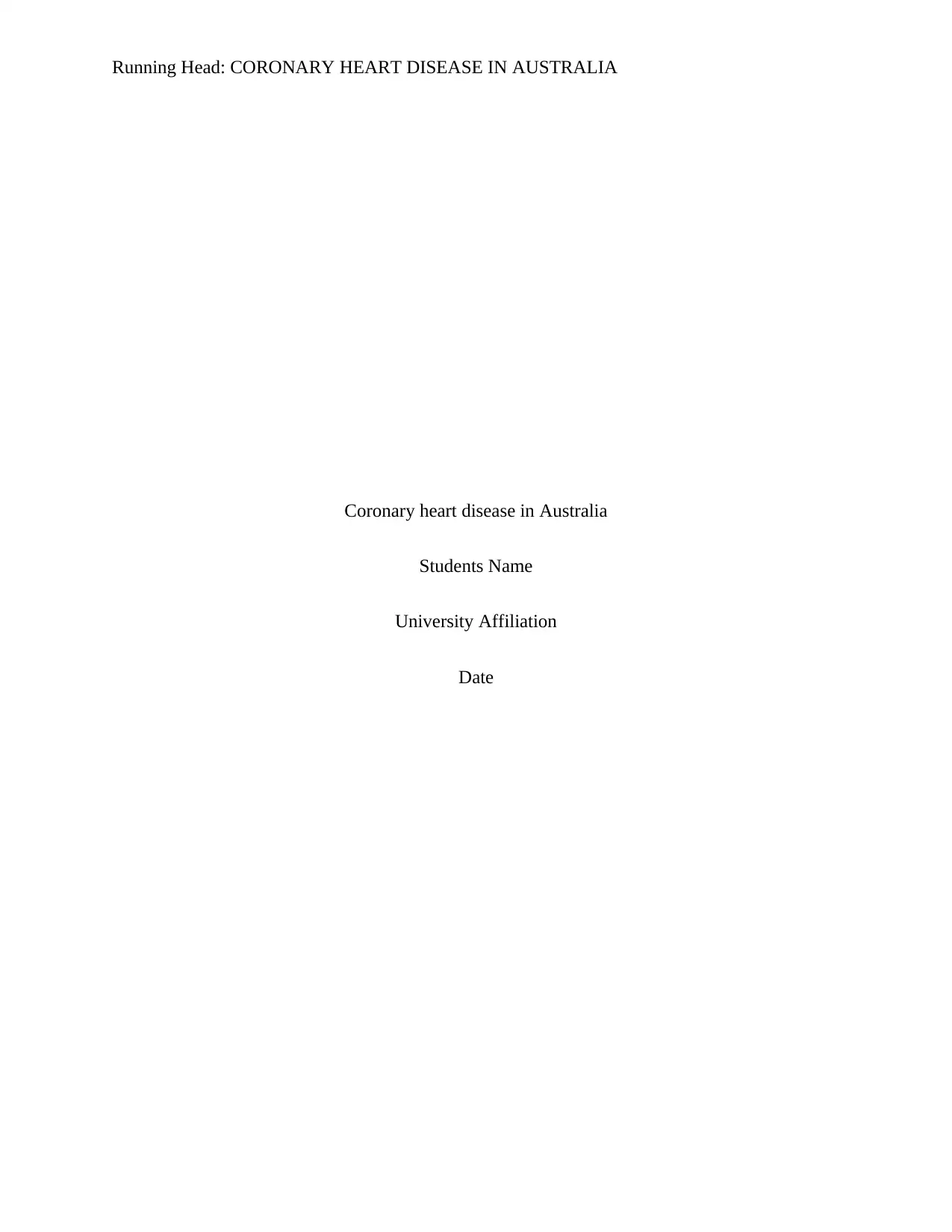
Running Head: CORONARY HEART DISEASE IN AUSTRALIA
Coronary heart disease in Australia
Students Name
University Affiliation
Date
Coronary heart disease in Australia
Students Name
University Affiliation
Date
Paraphrase This Document
Need a fresh take? Get an instant paraphrase of this document with our AI Paraphraser
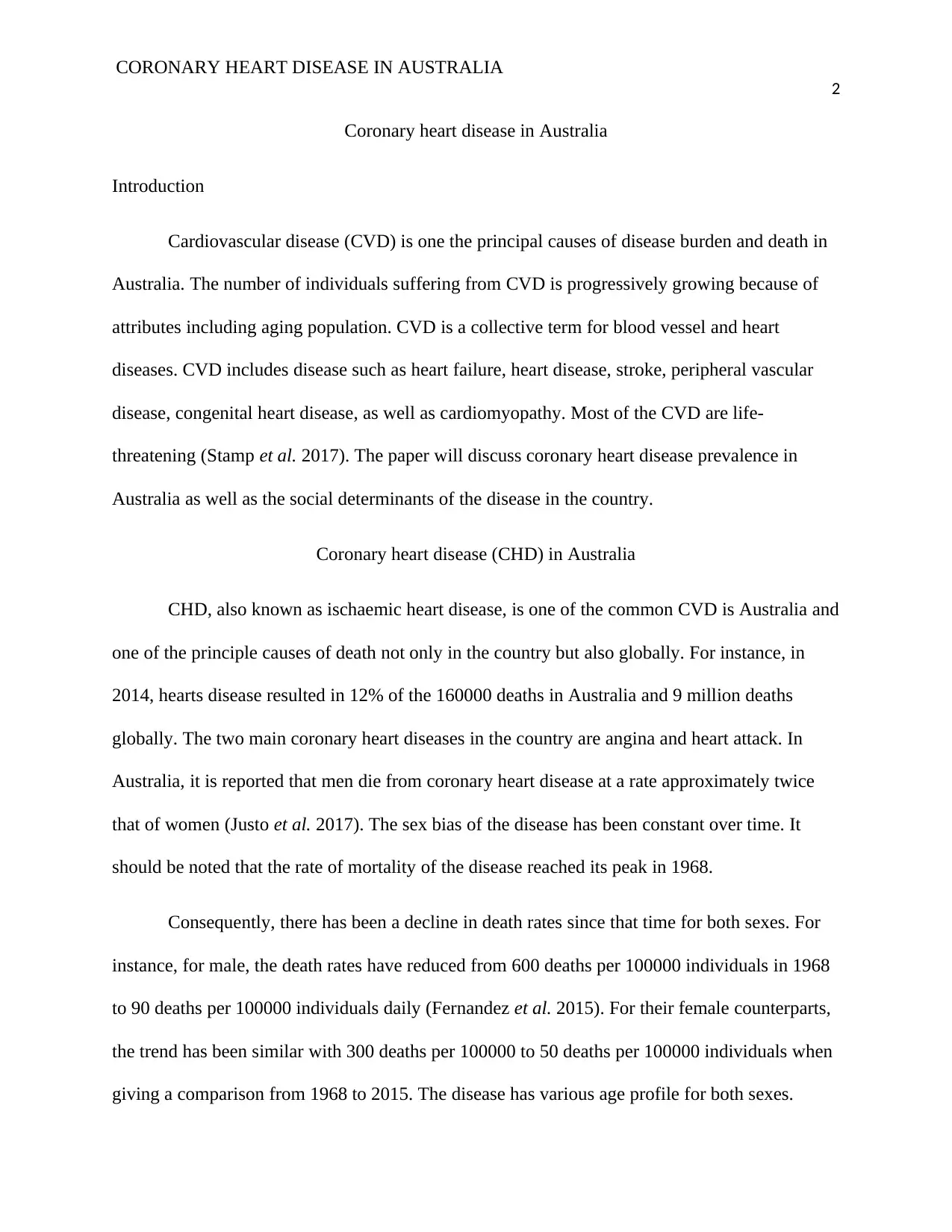
CORONARY HEART DISEASE IN AUSTRALIA
2
Coronary heart disease in Australia
Introduction
Cardiovascular disease (CVD) is one the principal causes of disease burden and death in
Australia. The number of individuals suffering from CVD is progressively growing because of
attributes including aging population. CVD is a collective term for blood vessel and heart
diseases. CVD includes disease such as heart failure, heart disease, stroke, peripheral vascular
disease, congenital heart disease, as well as cardiomyopathy. Most of the CVD are life-
threatening (Stamp et al. 2017). The paper will discuss coronary heart disease prevalence in
Australia as well as the social determinants of the disease in the country.
Coronary heart disease (CHD) in Australia
CHD, also known as ischaemic heart disease, is one of the common CVD is Australia and
one of the principle causes of death not only in the country but also globally. For instance, in
2014, hearts disease resulted in 12% of the 160000 deaths in Australia and 9 million deaths
globally. The two main coronary heart diseases in the country are angina and heart attack. In
Australia, it is reported that men die from coronary heart disease at a rate approximately twice
that of women (Justo et al. 2017). The sex bias of the disease has been constant over time. It
should be noted that the rate of mortality of the disease reached its peak in 1968.
Consequently, there has been a decline in death rates since that time for both sexes. For
instance, for male, the death rates have reduced from 600 deaths per 100000 individuals in 1968
to 90 deaths per 100000 individuals daily (Fernandez et al. 2015). For their female counterparts,
the trend has been similar with 300 deaths per 100000 to 50 deaths per 100000 individuals when
giving a comparison from 1968 to 2015. The disease has various age profile for both sexes.
2
Coronary heart disease in Australia
Introduction
Cardiovascular disease (CVD) is one the principal causes of disease burden and death in
Australia. The number of individuals suffering from CVD is progressively growing because of
attributes including aging population. CVD is a collective term for blood vessel and heart
diseases. CVD includes disease such as heart failure, heart disease, stroke, peripheral vascular
disease, congenital heart disease, as well as cardiomyopathy. Most of the CVD are life-
threatening (Stamp et al. 2017). The paper will discuss coronary heart disease prevalence in
Australia as well as the social determinants of the disease in the country.
Coronary heart disease (CHD) in Australia
CHD, also known as ischaemic heart disease, is one of the common CVD is Australia and
one of the principle causes of death not only in the country but also globally. For instance, in
2014, hearts disease resulted in 12% of the 160000 deaths in Australia and 9 million deaths
globally. The two main coronary heart diseases in the country are angina and heart attack. In
Australia, it is reported that men die from coronary heart disease at a rate approximately twice
that of women (Justo et al. 2017). The sex bias of the disease has been constant over time. It
should be noted that the rate of mortality of the disease reached its peak in 1968.
Consequently, there has been a decline in death rates since that time for both sexes. For
instance, for male, the death rates have reduced from 600 deaths per 100000 individuals in 1968
to 90 deaths per 100000 individuals daily (Fernandez et al. 2015). For their female counterparts,
the trend has been similar with 300 deaths per 100000 to 50 deaths per 100000 individuals when
giving a comparison from 1968 to 2015. The disease has various age profile for both sexes.
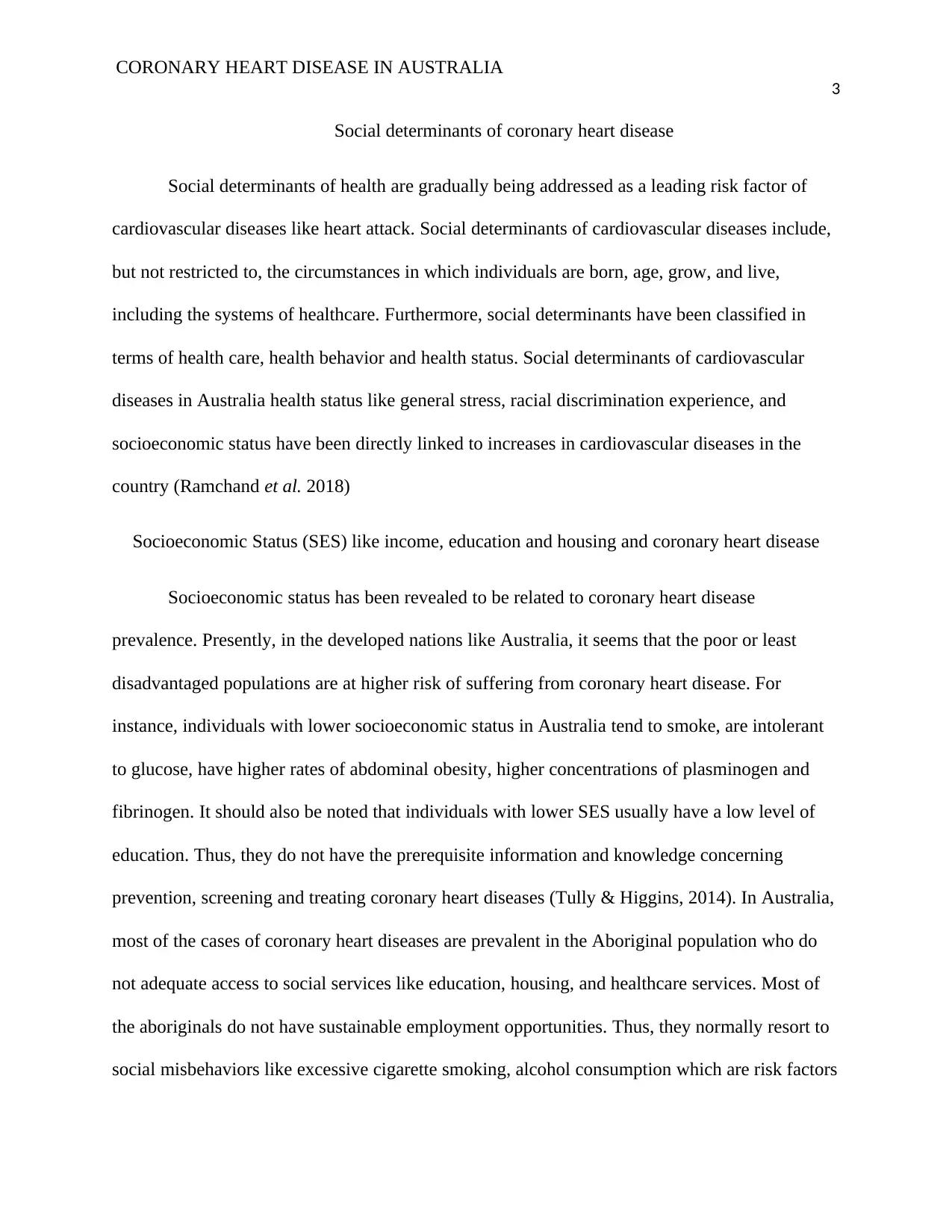
CORONARY HEART DISEASE IN AUSTRALIA
3
Social determinants of coronary heart disease
Social determinants of health are gradually being addressed as a leading risk factor of
cardiovascular diseases like heart attack. Social determinants of cardiovascular diseases include,
but not restricted to, the circumstances in which individuals are born, age, grow, and live,
including the systems of healthcare. Furthermore, social determinants have been classified in
terms of health care, health behavior and health status. Social determinants of cardiovascular
diseases in Australia health status like general stress, racial discrimination experience, and
socioeconomic status have been directly linked to increases in cardiovascular diseases in the
country (Ramchand et al. 2018)
Socioeconomic Status (SES) like income, education and housing and coronary heart disease
Socioeconomic status has been revealed to be related to coronary heart disease
prevalence. Presently, in the developed nations like Australia, it seems that the poor or least
disadvantaged populations are at higher risk of suffering from coronary heart disease. For
instance, individuals with lower socioeconomic status in Australia tend to smoke, are intolerant
to glucose, have higher rates of abdominal obesity, higher concentrations of plasminogen and
fibrinogen. It should also be noted that individuals with lower SES usually have a low level of
education. Thus, they do not have the prerequisite information and knowledge concerning
prevention, screening and treating coronary heart diseases (Tully & Higgins, 2014). In Australia,
most of the cases of coronary heart diseases are prevalent in the Aboriginal population who do
not adequate access to social services like education, housing, and healthcare services. Most of
the aboriginals do not have sustainable employment opportunities. Thus, they normally resort to
social misbehaviors like excessive cigarette smoking, alcohol consumption which are risk factors
3
Social determinants of coronary heart disease
Social determinants of health are gradually being addressed as a leading risk factor of
cardiovascular diseases like heart attack. Social determinants of cardiovascular diseases include,
but not restricted to, the circumstances in which individuals are born, age, grow, and live,
including the systems of healthcare. Furthermore, social determinants have been classified in
terms of health care, health behavior and health status. Social determinants of cardiovascular
diseases in Australia health status like general stress, racial discrimination experience, and
socioeconomic status have been directly linked to increases in cardiovascular diseases in the
country (Ramchand et al. 2018)
Socioeconomic Status (SES) like income, education and housing and coronary heart disease
Socioeconomic status has been revealed to be related to coronary heart disease
prevalence. Presently, in the developed nations like Australia, it seems that the poor or least
disadvantaged populations are at higher risk of suffering from coronary heart disease. For
instance, individuals with lower socioeconomic status in Australia tend to smoke, are intolerant
to glucose, have higher rates of abdominal obesity, higher concentrations of plasminogen and
fibrinogen. It should also be noted that individuals with lower SES usually have a low level of
education. Thus, they do not have the prerequisite information and knowledge concerning
prevention, screening and treating coronary heart diseases (Tully & Higgins, 2014). In Australia,
most of the cases of coronary heart diseases are prevalent in the Aboriginal population who do
not adequate access to social services like education, housing, and healthcare services. Most of
the aboriginals do not have sustainable employment opportunities. Thus, they normally resort to
social misbehaviors like excessive cigarette smoking, alcohol consumption which are risk factors
⊘ This is a preview!⊘
Do you want full access?
Subscribe today to unlock all pages.

Trusted by 1+ million students worldwide
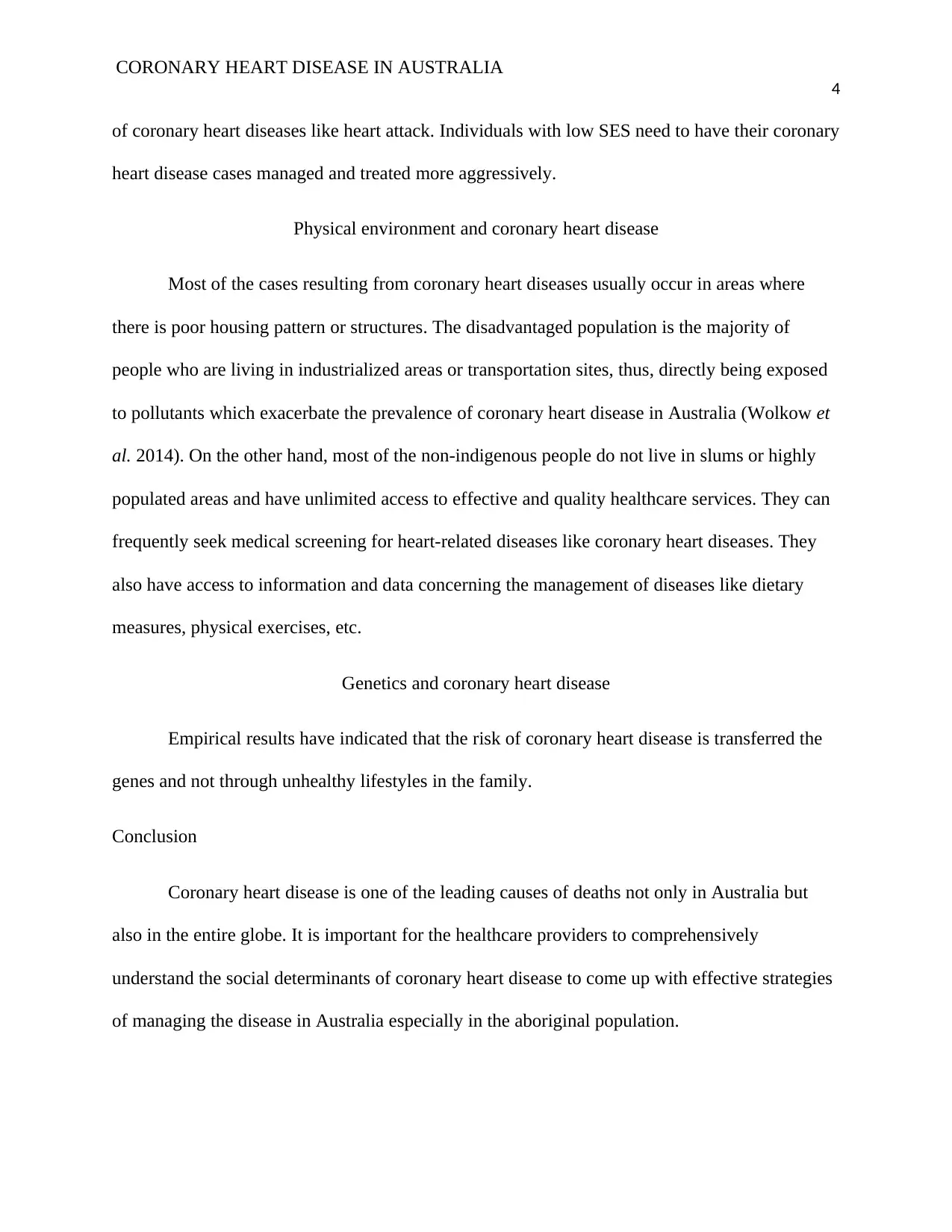
CORONARY HEART DISEASE IN AUSTRALIA
4
of coronary heart diseases like heart attack. Individuals with low SES need to have their coronary
heart disease cases managed and treated more aggressively.
Physical environment and coronary heart disease
Most of the cases resulting from coronary heart diseases usually occur in areas where
there is poor housing pattern or structures. The disadvantaged population is the majority of
people who are living in industrialized areas or transportation sites, thus, directly being exposed
to pollutants which exacerbate the prevalence of coronary heart disease in Australia (Wolkow et
al. 2014). On the other hand, most of the non-indigenous people do not live in slums or highly
populated areas and have unlimited access to effective and quality healthcare services. They can
frequently seek medical screening for heart-related diseases like coronary heart diseases. They
also have access to information and data concerning the management of diseases like dietary
measures, physical exercises, etc.
Genetics and coronary heart disease
Empirical results have indicated that the risk of coronary heart disease is transferred the
genes and not through unhealthy lifestyles in the family.
Conclusion
Coronary heart disease is one of the leading causes of deaths not only in Australia but
also in the entire globe. It is important for the healthcare providers to comprehensively
understand the social determinants of coronary heart disease to come up with effective strategies
of managing the disease in Australia especially in the aboriginal population.
4
of coronary heart diseases like heart attack. Individuals with low SES need to have their coronary
heart disease cases managed and treated more aggressively.
Physical environment and coronary heart disease
Most of the cases resulting from coronary heart diseases usually occur in areas where
there is poor housing pattern or structures. The disadvantaged population is the majority of
people who are living in industrialized areas or transportation sites, thus, directly being exposed
to pollutants which exacerbate the prevalence of coronary heart disease in Australia (Wolkow et
al. 2014). On the other hand, most of the non-indigenous people do not live in slums or highly
populated areas and have unlimited access to effective and quality healthcare services. They can
frequently seek medical screening for heart-related diseases like coronary heart diseases. They
also have access to information and data concerning the management of diseases like dietary
measures, physical exercises, etc.
Genetics and coronary heart disease
Empirical results have indicated that the risk of coronary heart disease is transferred the
genes and not through unhealthy lifestyles in the family.
Conclusion
Coronary heart disease is one of the leading causes of deaths not only in Australia but
also in the entire globe. It is important for the healthcare providers to comprehensively
understand the social determinants of coronary heart disease to come up with effective strategies
of managing the disease in Australia especially in the aboriginal population.
Paraphrase This Document
Need a fresh take? Get an instant paraphrase of this document with our AI Paraphraser
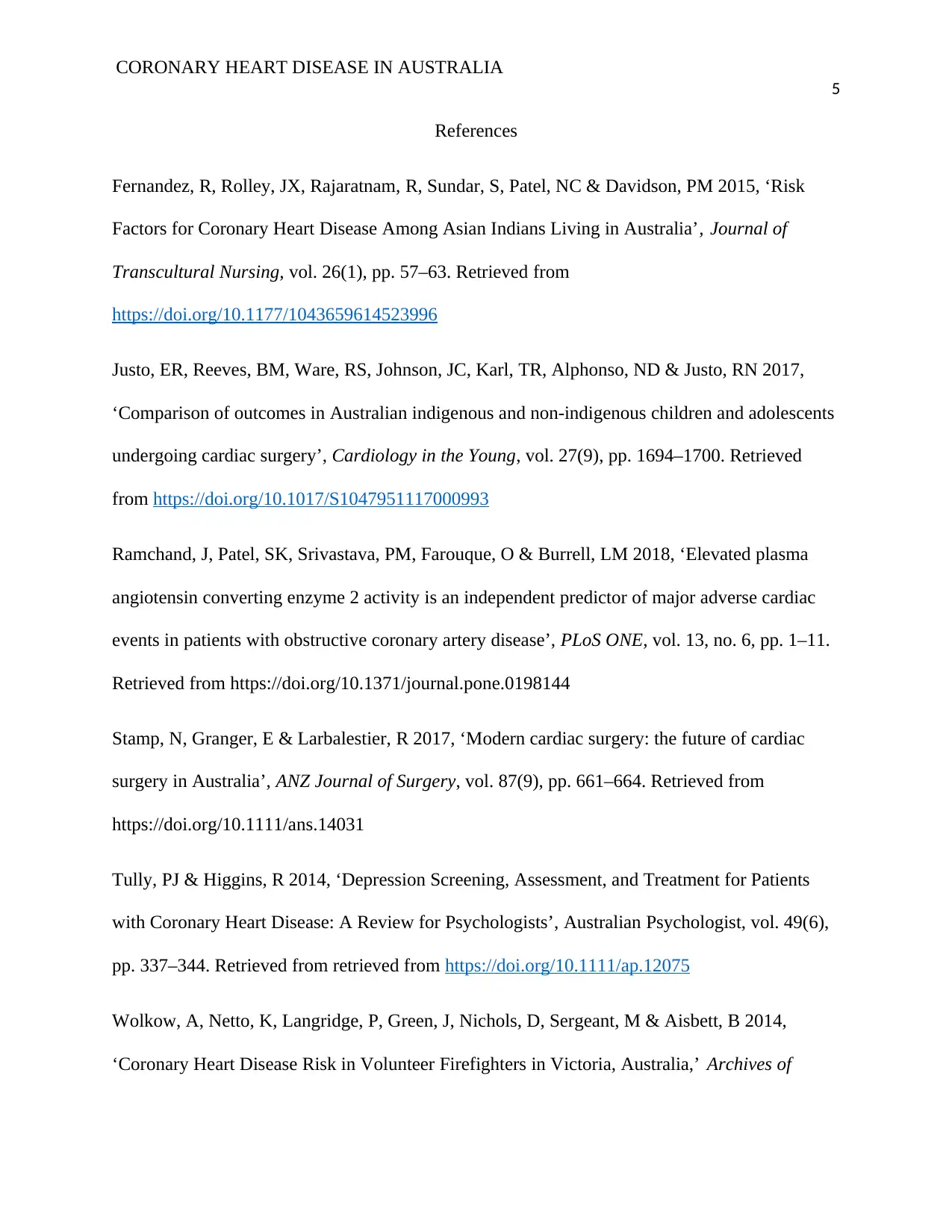
CORONARY HEART DISEASE IN AUSTRALIA
5
References
Fernandez, R, Rolley, JX, Rajaratnam, R, Sundar, S, Patel, NC & Davidson, PM 2015, ‘Risk
Factors for Coronary Heart Disease Among Asian Indians Living in Australia’, Journal of
Transcultural Nursing, vol. 26(1), pp. 57–63. Retrieved from
https://doi.org/10.1177/1043659614523996
Justo, ER, Reeves, BM, Ware, RS, Johnson, JC, Karl, TR, Alphonso, ND & Justo, RN 2017,
‘Comparison of outcomes in Australian indigenous and non-indigenous children and adolescents
undergoing cardiac surgery’, Cardiology in the Young, vol. 27(9), pp. 1694–1700. Retrieved
from https://doi.org/10.1017/S1047951117000993
Ramchand, J, Patel, SK, Srivastava, PM, Farouque, O & Burrell, LM 2018, ‘Elevated plasma
angiotensin converting enzyme 2 activity is an independent predictor of major adverse cardiac
events in patients with obstructive coronary artery disease’, PLoS ONE, vol. 13, no. 6, pp. 1–11.
Retrieved from https://doi.org/10.1371/journal.pone.0198144
Stamp, N, Granger, E & Larbalestier, R 2017, ‘Modern cardiac surgery: the future of cardiac
surgery in Australia’, ANZ Journal of Surgery, vol. 87(9), pp. 661–664. Retrieved from
https://doi.org/10.1111/ans.14031
Tully, PJ & Higgins, R 2014, ‘Depression Screening, Assessment, and Treatment for Patients
with Coronary Heart Disease: A Review for Psychologists’, Australian Psychologist, vol. 49(6),
pp. 337–344. Retrieved from retrieved from https://doi.org/10.1111/ap.12075
Wolkow, A, Netto, K, Langridge, P, Green, J, Nichols, D, Sergeant, M & Aisbett, B 2014,
‘Coronary Heart Disease Risk in Volunteer Firefighters in Victoria, Australia,’ Archives of
5
References
Fernandez, R, Rolley, JX, Rajaratnam, R, Sundar, S, Patel, NC & Davidson, PM 2015, ‘Risk
Factors for Coronary Heart Disease Among Asian Indians Living in Australia’, Journal of
Transcultural Nursing, vol. 26(1), pp. 57–63. Retrieved from
https://doi.org/10.1177/1043659614523996
Justo, ER, Reeves, BM, Ware, RS, Johnson, JC, Karl, TR, Alphonso, ND & Justo, RN 2017,
‘Comparison of outcomes in Australian indigenous and non-indigenous children and adolescents
undergoing cardiac surgery’, Cardiology in the Young, vol. 27(9), pp. 1694–1700. Retrieved
from https://doi.org/10.1017/S1047951117000993
Ramchand, J, Patel, SK, Srivastava, PM, Farouque, O & Burrell, LM 2018, ‘Elevated plasma
angiotensin converting enzyme 2 activity is an independent predictor of major adverse cardiac
events in patients with obstructive coronary artery disease’, PLoS ONE, vol. 13, no. 6, pp. 1–11.
Retrieved from https://doi.org/10.1371/journal.pone.0198144
Stamp, N, Granger, E & Larbalestier, R 2017, ‘Modern cardiac surgery: the future of cardiac
surgery in Australia’, ANZ Journal of Surgery, vol. 87(9), pp. 661–664. Retrieved from
https://doi.org/10.1111/ans.14031
Tully, PJ & Higgins, R 2014, ‘Depression Screening, Assessment, and Treatment for Patients
with Coronary Heart Disease: A Review for Psychologists’, Australian Psychologist, vol. 49(6),
pp. 337–344. Retrieved from retrieved from https://doi.org/10.1111/ap.12075
Wolkow, A, Netto, K, Langridge, P, Green, J, Nichols, D, Sergeant, M & Aisbett, B 2014,
‘Coronary Heart Disease Risk in Volunteer Firefighters in Victoria, Australia,’ Archives of

CORONARY HEART DISEASE IN AUSTRALIA
6
Environmental & Occupational Health, vol. 69(2), pp. 112–120. Retrieved from
https://doi.org/10.1080/19338244.2012.750588
6
Environmental & Occupational Health, vol. 69(2), pp. 112–120. Retrieved from
https://doi.org/10.1080/19338244.2012.750588
⊘ This is a preview!⊘
Do you want full access?
Subscribe today to unlock all pages.

Trusted by 1+ million students worldwide
1 out of 6
Related Documents
Your All-in-One AI-Powered Toolkit for Academic Success.
+13062052269
info@desklib.com
Available 24*7 on WhatsApp / Email
![[object Object]](/_next/static/media/star-bottom.7253800d.svg)
Unlock your academic potential
Copyright © 2020–2025 A2Z Services. All Rights Reserved. Developed and managed by ZUCOL.





